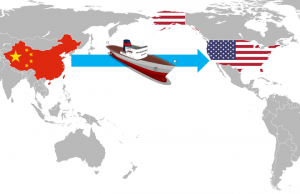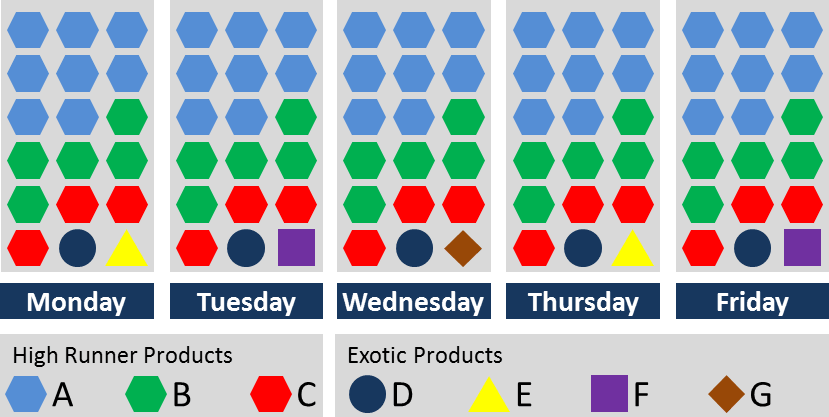 This post will list a number of tools that can help to reduce fluctuations. They can reduce fluctuations in the material flow, including its inventories and the durations and lead times. Since reducing fluctuations (mura) is an underlying important idea throughout lean manufacturing, a lot of tools can help. And, depending on how you interpret tools, this list is not even complete.
This post will list a number of tools that can help to reduce fluctuations. They can reduce fluctuations in the material flow, including its inventories and the durations and lead times. Since reducing fluctuations (mura) is an underlying important idea throughout lean manufacturing, a lot of tools can help. And, depending on how you interpret tools, this list is not even complete.
Source – Make – Deliver
 Fluctuations can happen anywhere along the value stream, or even outside it if a support process acts up. But most commonly it happens in the value stream before your area, in your area, or downstream of your area. Hence I have listed selected methods from the lean toolbox along source, make, and deliver. The source may be your suppliers, but also could be production systems in house that supply your area with material. In general, it is upstream of your area. Similarly, deliver could be your customer, or a production system in house that takes your material. In general, it is downstream of your area.
Fluctuations can happen anywhere along the value stream, or even outside it if a support process acts up. But most commonly it happens in the value stream before your area, in your area, or downstream of your area. Hence I have listed selected methods from the lean toolbox along source, make, and deliver. The source may be your suppliers, but also could be production systems in house that supply your area with material. In general, it is upstream of your area. Similarly, deliver could be your customer, or a production system in house that takes your material. In general, it is downstream of your area.
I have grouped these tools where they have the largest impact, although many of them have a positive effect on the entire value stream. Leveling is one example that can reduce fluctuations both downstream and upstream. Most of these tools can be done within your area to have a positive effect somewhere else in the value stream, which in turn will again benefit you.
Source
Reduce Part Variants
One way to reduce fluctuations is to reduce part variants. It is general wisdom (and also accepted science) that larger parts volume fluctuate proportionally less than smaller part volumes. The product you make only a few times per year will be much more random than the product you make every day. Hence, reducing part variants will reduce your fluctuations.
Below is a structure on how to decide if you can remove a part. However, I can tell you by experience that reducing a part variant is an uphill battle. It feels like Sisyphus work. You put in a lot of effort to reduce three part variants, and at the same time thirty new part variants are introduced. To change part variants, you need support from design and development. Unfortunately, design and development lives to create new stuff, not to eliminate old stuff, and hence they may be less enthusiastic about it. For more on how to reduce part variants see my posts on Design for Assembly Questions Part 1 and Part 2.

Local Suppliers

Another option is to use more local suppliers. The farther away your supplier is, the longer it takes for material to arrive. Any adjustments or changes need time to pass through the value stream before they are effective at your location. Similarly, but usually underestimated, the distance also makes the information flow more difficult. Long distance communication is possible, of course. But a lot more information can be conveyed and faster if you just visit your supplier or vice versa.
This delay in material and information flow increases fluctuations, as it takes time to work against them. If your sales go down and you want to reduce production, tough luck. You still have three months of goods in the supply chain from overseas. You either produce and store completed goods, or store excess parts. Chances are also that you may overreact and tell the overseas source not to produce anything, since you have three months’ worth of inventory that you don’t need. When the market improves again, it will take three months to get parts again. What I just described you is the well-known bullwhip effect. We had exactly this situation during the 2007 financial crisis, and will have the same situation during COVID-19.
Many automotive plants try to have local suppliers. Seat makers especially are often literally next door or even on-site at the car plant. Toyota in Toyota City has the majority of its suppliers within a two-hour truck drive, making it so much easier to deliver just in time.
Leveling
 Leveling is a major tool to reduce fluctuations. I listed it here under “Source,” but it also has a large effect on the “Make” part. I.e., it will not only make life easier for your supplier, but also for you.
Leveling is a major tool to reduce fluctuations. I listed it here under “Source,” but it also has a large effect on the “Make” part. I.e., it will not only make life easier for your supplier, but also for you.
Please note that there are different ways to level. I am all in favor of sequencing your lot sizes every day as evenly as possible. This should be feasible for pretty much everybody, regardless of lot size.
I am very hesitant to use a longer pattern. Often, leveling is seen as a multi-week pattern, where the entire production plan is defined weeks in advance. The major (!) problem is that due to other fluctuations, very few companies can actually follow a production plan that was set up weeks ago. Most companies can’t reliably produce on Wednesday what they planned on Monday! Being forced to change the multi-week plan on short notice will increase the fluctuations, not reduce it. Hence, such a multi-week pattern often has the opposite effect of INCREASING fluctuations!
You can find more on leveling in my series of posts starting with Why Leveling (Heijunka) Is Important, including the good approach Introduction to One-Piece Flow Leveling Part 1 and Part 2, and the not-so-good approach Folly of EPEI Leveling in Practice Part 1 and Part 2.
Reduce Lot Size

Finally, you can reduce fluctuations simply by reducing your lot size. This will also have beneficial effects on both your source and your own area. The perfect lot size is one. However, not every company can achieve a lot size of one right away. However, reducing a lot size is in general beneficial, as long as you can still produce what you need within the given time including change overs. And, always remember, change overs can be optimized using SMED! Any reduction in changeover time is usually best invested in more changeovers and a reduction in lot size. For more, see my series of posts starting with How to Determine Your Lot Size. For some inspirational examples, look at Toyota’s and Denso’s Relentless Quest for Lot Size One.
In my next post I will look at tools that can help you with reducing fluctuations in your own area, in “make.” Now, go out, reduce your source fluctuations, and organize your industry!
Series Overview
- Why Are Fluctuations So Bad?
- Structure for Reducing Fluctuations
- Reducing Fluctuations Upstream
- Reducing Fluctuations on Your Shop Floor
- Reducing Fluctuations Downstream



Hi Christoph,
Another great article. Thanks for sharing. Always appreciate to read your valuable posts.
Regards,
Kaan
Hi Christoph, great article!
Reducing the variability is certainly the most important step to then apply JIT and reach OPF.
Only, just be careful not to reduce the “positive” variability (see Rajan Suri), which derives for example from an intelligent increase in the product mix or from the customization required by the market.
Hi Chris!
Great article! I think your point about using local suppliers is a great idea. Especially now during a pandemic, supplies may take much longer than anticipated, so having a supplier close by is great in a pinch!
Hi Chris-
I enjoyed reading your blog post! Your insight on reduction of variant parts to combat fluctuations is so helpful. I agree that when deciding which parts to eliminate one should investigate its design and development. Continually improving products and parts is a key part of lean !